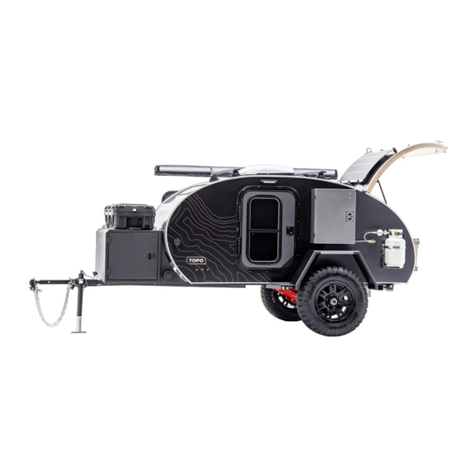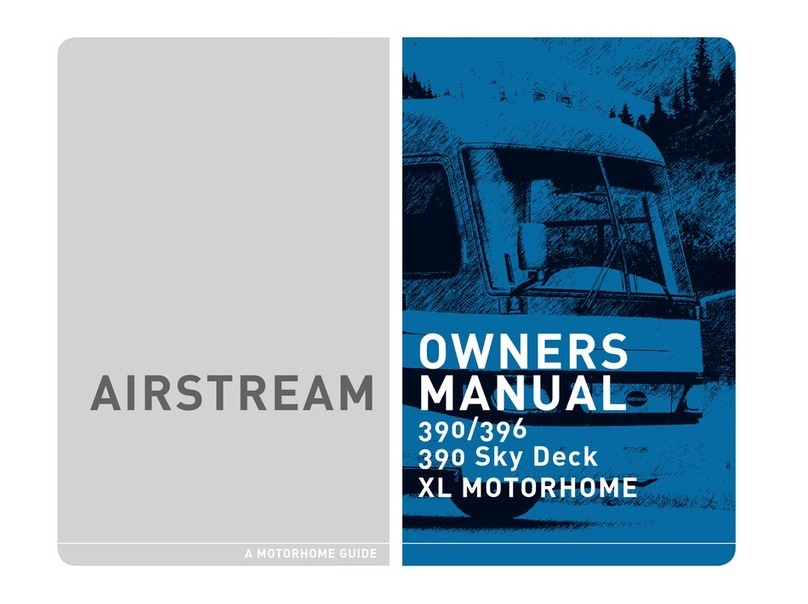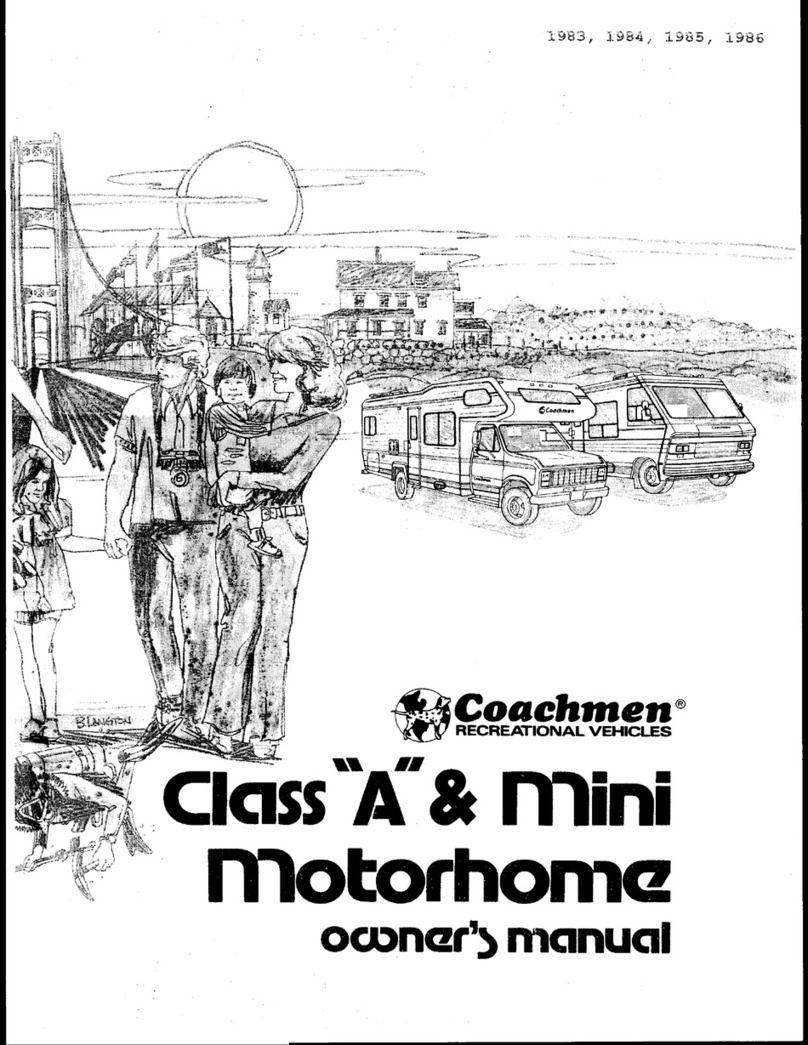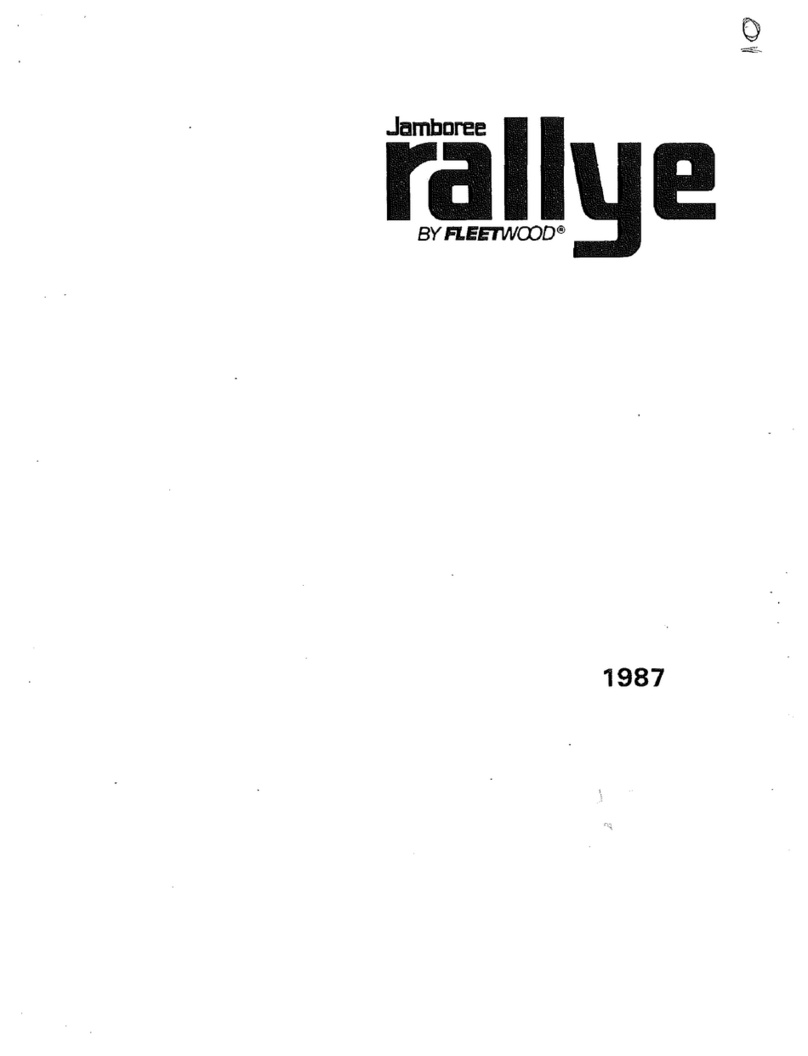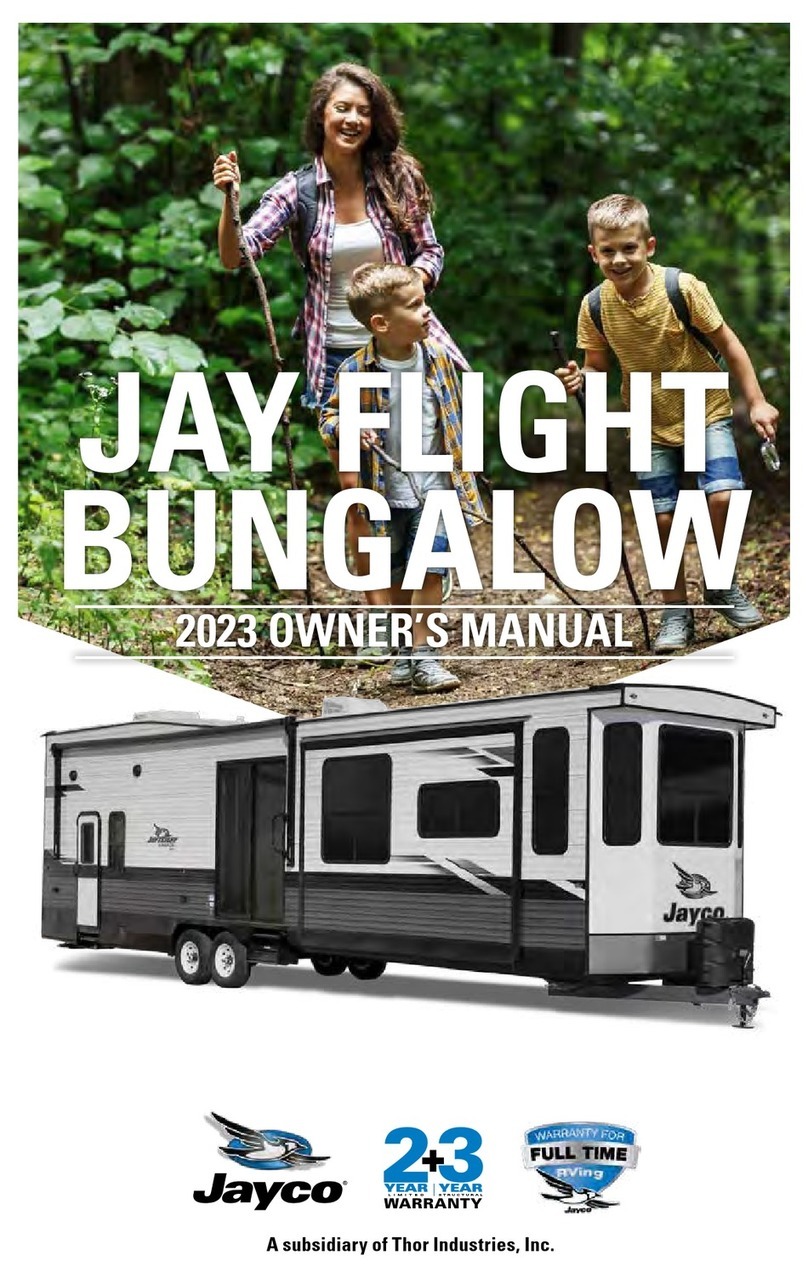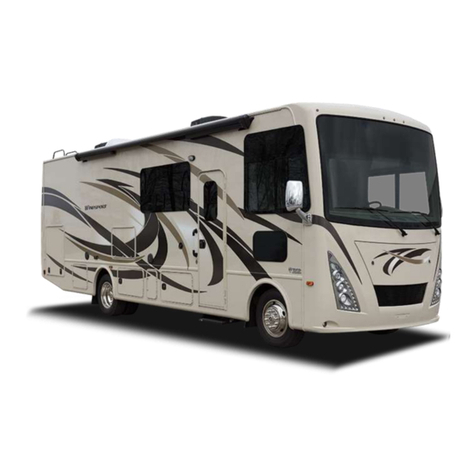Escapod Original TOPO Series User manual

Escapod Owner’s Manual
Original TOPO Series
—
07/2023
1

Escapod Trailers Original Topo Owner’s Manual
Version 2023.07
Disclaimers
The information contained within the manual including specifications, illustrations, and
content are based on the latest production information available at the time of publication
approval. Improvements to product, changes in manufacturing techniques, and changes to or
substitution of product due to experience improvement or physical availability may not be
wholly represented in this manual and such changes are at the sole discretion of Escapod
Trailers LLC (Escapod). In addition, Escapod Trailers LLC reserves the right to make changes to
the equipment, form, technical systems or layout of the Original Topo as it sees fit to be
innovative and beneficial. Therefore, no legal claims may be filed against Escapod Trailers, LLC
based on the contents of this manual. Escapod Trailers LLC is not responsible for the
observance or nonobservance of this instruction manual. Any given specifications may be
subject to change without notice. Recorded tongue weights, overall weights, fuel, liquid
capacities, consumption rates, and dimensions may also be approximate.
Operating Procedures
All operating procedures contained within the manual are described under ordinary conditions.
It is the responsibility of the Original Topo owner to perform safe operations of their trailer
and all systems contained therein. Escapod Trailers cannot be held liable for any injury or loss
which is a result of the user improperly using or the non-observance of any procedures or
safety warnings supplied in this manual or any other third-party manuals or documentation
referenced herein or provided with the trailer.
External Websites
The third party websites and documentation referenced in this manual are meant to assist in
the acquisition of additional knowledge of products contained within your Original Topo. The
information presented through these links are subject to change without notice and Escapod
Trailers LLC has no control over the content accessed unless Escapod Trailers is the creator of
the content. Therefore, no liability whatsoever shall be assumed by Escapod Trailers in
connection with these websites, be it information, external links, third-party links, errors,
omissions, inaccuracies or any other content on the websites. These websites are for use
strictly at your own risk. Most of the information is meant to be of a general nature and may
not pertain to your circumstances. Escapod Trailers has no control over third-party vendors
and supplier websites and therefore will assume no responsibility for any type of loss or injury
sustained from its actions, omissions or negligence. It is not considered legal advice.
2

Optional Items
The Original Topo oers multiple areas for optional items to be added or substituted for parts
included in the base build. Some of these optional things may be added after the build has
been completed, while others may only happen during the original manufacturing process and
cannot be added once the trailer has come o the manufacturing line. Operation and
troubleshooting of all options are included within the manual. The presence of this
information does not imply availability or application/installation of any optional feature.
Installation of optional items not approved by Escapod or by a shop not authorized by
Escapod Trailers may result in voiding the warranty.
Discontinuation of the Original Topo - Part Availability
In December of 2022, Escapod made the decision to discontinue the production of the Original
Topo. While we will continue to support our flagship product through its lifecycle, the
availability of parts custom made for that trailer will be limited and may take extended time
to procure or create or may not be available at all. Parts that are custom made include but are
not limited to:
●Aluminum tongue box with or without drawer slides
●Tongue deck
●Coated spare tire mount
●Powdercoated hot water heater surface mounted box
●Magnetic rings surrounding the door windows and stargazer for use with blackout
window covers
●Mattress
If you wish to add or replace parts which are not custom made, please contact the individual
procuring the needed replacement parts.
Substitute Parts
While we have done our best to acknowledge part changes and rough timelines of
implementation, there will be some missed changes. The Original Topo was always evolving
and changing as we worked toward building “the best damn camper known to man.” Therefore
changes in manufacturing process and the use of dierent but equivalent parts were not
always accurately recorded. If you have parts or configurations not identified in this manual,
Known part changes are highlighted in the blue boxes throughout this manual.
Orientation
Throughout this manual we refer to the “driver” or “passenger” side when referring to
orientation of features or points of interest on your trailer. This allows the description of the
orientation to remain consistent and be anchored to the fixed trailer rather than the variable
3

position of the person (or looker). Driver and passenger side orientation refers to the side of
the trailer that corresponds to the tow vehicle when it is hooked up
Height measurements also require an orientation and clarification. All height measurements in
this manual refer to trailers built with an independent arm suspension (either the Timbren or
Escapod Freeride suspension upgrade). If your trailer has a straight axle, the overall height
measurements of the trailer will be 1-2” shorter than noted.
4

Table of Contents
Disclaimers 2
Operating Procedures 2
External Websites 2
Optional Items 3
Discontinuation of the Original Topo - Part Availability 3
Substitute Parts 3
Orientation 3
Table of Contents 5
Introduction 11
Welcome 11
Manual Notes 12
Owner’s Packet 12
General Safety 13
Introduction 13
Reporting Safety Defects 13
Fire Safety 14
Carbon Monoxide 15
Emergency Preparedness 15
General Maintenance Toolkit 15
Towing 16
Tow Vehicle Requirements 16
Loading and Load Distribution 16
Towing Considerations 17
Electric Brakes (Optional) 19
How Electric Brakes Work 19
Component Details 19
Vehicle Hitch and Trailer Coupler 20
Fully Articulating Hitch (Optional) 21
Maintenance 22
Driving Lights and Electrical Connections 23
Flat Four Connection 23
7-Pin Round Connection 23
Junction Box 24
Tires/Wheels 25
2017-2020 Oering 25
2021-2022 Oering 25
Lug Nuts 26
Tire Maintenance 26
5

Storage 28
Spare Tire (Optional) 28
Accessing Your Spare 28
Safety Chains 29
Hooking Up 30
Hooking Up - Trailer Check 32
Check Prior to Hooking Up 33
Check Prior to Departing 33
Towing Troubleshooting/FAQ 33
Leveling and Camp Set-Up 34
Unhooking Your Trailer 35
Stabilizing 35
Bal Rear Stabilizing Jacks 36
Pull to Release Back Stabilizers 36
Awning Set-Up 37
Quick Set-up 38
Warranty 38
Awning Annex Room (Optional) 39
Quick Set-up 39
Warranty 39
Rooftop Tent (Optional) 39
Setup Considerations 39
Warranty 40
Leveling and Camp Set Up Troubleshooting 40
Frame 41
Vehicle Identification Number (VIN) 41
Fenders 42
Frame Maintenance 42
Rear Hitch Receiver 42
Maintenance 43
Suspension 43
Standard Axle 43
Timbren Axle-Less Suspension (Optional) 43
Freeride Independent Arm Suspension (Optional) Overview 43
Maintenance 44
Freeride Suspension Maintenance Schedule 45
Alignment 47
Quick Alignment Check 47
Checking Suspension Bolts 49
Hubs and Drums 50
6

Maintenance 50
Body 50
Vinyl 51
Aluminum Walls/Roof 51
Clear Bra (Optional) 51
Roof Rack System 52
Maintenance 52
Bolts to Check - Foot to Bar 52
Bolts to Check - Awning to Bars 53
Exterior Lights 53
Washing/Cleaning/Maintenance 53
Tongue Storage 55
Steel Tongue Deck 55
Aluminum Tongue Box 55
Maintenance 56
Cabin 56
Headboard 56
Mattress 56
Cabinet Storage 57
Stargazer 58
Doors/Handles 58
Doors 58
Water Ingress 58
Handles 59
Door Bug Screens (Optional) 60
Window Covers (Optional) 60
Cleaning and Maintenance 60
Cabin Troubleshooting 61
Galley 61
Hatch 61
Cabinets 61
Table 62
Set-up Option 1 63
Set-up Option 2 63
Table Mount Locations 64
Countertop 64
Drawers 64
Removing/Replacing the Drawers 64
Food Preservation 65
Yeti Tundra 65 65
7

Dometic CFX3 35 (Optional) 65
Cleaning and Maintenance 66
General Galley Troubleshooting 66
Cooling/Ventilation 67
Maxxfan 67
Fan Quick Start 68
General Information 68
Fresair S7i Air Cooling Unit (Optional) 68
Fresiar Quick Start 68
General Information 68
Winterizing 69
Ventilation Troubleshooting 69
Cabin Heating (Optional) 70
Vents 70
Internal Vent 70
External Vent 71
Propex Quick Start 71
Heating Troubleshooting 72
Plumbing/Water System (Optional) 72
Water Tank (Optional) 73
Accessing the Tank 73
Filling the Tank 74
Emptying the Tank 74
Water Consumption 75
Water Pump 75
Accessing the Pump 75
Water Heater/Shower (Optional) 76
Water Heater Quick Start 76
Gray Water 77
Gray Water 77
Disposal of Grey Water 77
Winterizing 77
Winterizing the Water Tank 78
Winterizing the Water Heater 79
Winterizing the Fresair 81
Cleaning and Sanitation 81
De-Winterizing and Sanitizing 81
Plumbing Troubleshooting 82
Cooking/Propane 83
General Propane Safety 83
8

Propane Tank 84
To open/close propane tank 84
To remove the propane tank for exchange or fill 84
To reinstall a newly filled propane tank 84
Filling the Propane Tank 85
Propane Consumption 85
General Propane Tank Safety 86
Stove 86
Lighting the Stove 87
Stove Safety 87
Stove Cleaning and Maintenance 87
Stove Troubleshooting 87
Electrical System 88
Fuse Block 88
Shore Power 90
On-Board Battery Charger/Converter 90
Inverter (Optional) 91
Inverting Mode 91
Charging Mode 91
Xantrex Specific Information 92
Batteries 92
Maintenance 92
Best Practices 93
Battery Cut-o Switch 93
Removal 93
Solar Panel (Optional) 94
Mounting/Unmounting 94
Solar Controller 95
Lights 96
Power Plugs 96
Electrical System Troubleshooting 97
Other Optional Add-Ons 98
Air-Compressor 98
Roam Rugged Boxes 98
Warranty 99
General Troubleshooting 99
Warranty 100
Overview 100
Owner’s Responsibility 100
Escapod’s Responsibilities 100
9

Coverage 100
General 100
Component Warranties 101
Parts and Design Changes 101
Disclaimer of Consequential and Incidental Damages 101
Exclusions 101
Defect vs Damage 103
Owner Warranty Procedure 103
Statute of Limitation 104
Attorneys Fees 104
Addendum A: Component Warranties 104
Appendix 105
Component Manuals 105
Component Warranties 107
Season Readiness Checklist 109
Post-Season Storage Checklist 110
10

Introduction
Welcome
Congratulations on your purchase of an Escapod Original Topo, made by Escapod Trailers LLC
in Coalville, Utah.
Escapod was born out of necessity. A need to escape the daily grind at a moment’s notice, to
be unbounded by terrain and free to roam.
We believe that time is too precious to spend it tracking-down and packing-up camping gear.
We wanted a tent on wheels, always ready for our next adventure. The teardrop trailer seemed
like the right solution, but nothing on the market checked all our boxes. So, we designed and
built our own - the Original Topo.
Our mission was simple: build the best damn camper known to man - a teardrop trailer that’s
gentle on the eyes, rugged enough for the craziest adventures, and suitable for year-round
fun.
Blending the concept of a sleeping pod with the thrill of an escapade, the Escapod name was
formed. And after fumbling our way through some napkin doodles, we refined & digitized the
now-iconic “e” logo. In June 2016, Escapod was ocially born when the first pods were built
in our mom’s garage.
Our goal is simply to maximize our customer’s connection with the great outdoors by
providing dependable, hand-built teardrop trailers. Life’s demands may require you to change,
but your adventure doesn’t have to. Whether you’re a weekend warrior or a full-time
vagabond, there is an Escapod for you.
In this guide, you will find general knowledge about our trailers as well as some helpful hints
to make your experience with Escapod the best it can be. We are very excited you have joined
the Escapod family, and look forward to providing you with the best teardrop trailer
experience known to man.
Chris Hudak, Founder
11

Manual Notes
This manual is designed to provide you with foundational knowledge and understanding of the
operations of the Original Topo as well as provide quick troubleshooting assistance should
something not go to plan. It is to be used in conjunction with the operational videos on the
Escapod Trailers’ YouTube channel and component specific instructional manuals provided to
you when you took possession of the trailer. Should you have further questions, please check
out the Knowledge Base section of our website (https://escapod.us/knowledge-base), or
contact our after-sales Service and Warranty Team at support@escapod.us or 435-565-6329.
Support hours are Monday through Friday 8:30AM-4:30PM MST, excluding major holidays.
Please read and understand this entire manual focusing your attention on areas labeled
“DANGER,” “WARNING,” “CAUTION,” and “NOTICE” as they contain information related to your
safety and well-being and call out specific hazards within your trailer.
Sections labeled “Camping Tip,” “Helpful Hint,” or “Note” are some best practices we have
discovered over the years and wanted to share with you, or things that are useful to know.
These are exactly as described, hints, tips, or facts to make your experience more enjoyable,
and should not be considered ocial directives. Escapod will not be responsible for the
outcome if you do or do not follow them.
Separate instruction manuals for appliances, special components, or accessories are included
with your Original Topo, many of which can also be found in the Document Center of the
Escapod website (https://escapod.us/document-center) as well as linked in the Appendix of
this manual. These manuals provide part specific information and additional troubleshooting
not necessarily covered in this manual. Please refer to these manuals for components whose
warranties are not covered by Escapod, rather their own individual component warranty. See
the “Warranty” section of this document for a list of these parts.
All information in this manual should be considered part of the trailer and needs to be
transferred to new owners should the trailer be sold. We suggest downloading this manual to
a smart device or printing it so the information is easily accessible while you are enjoying your
Original Topo.
This manual is not intended to teach you how to camp or enjoy the outdoors. Rather it is
designed to show you how to use your Original Topo and provide helpful tips so you can
maximize your enjoyment of your purchase.
Owner’s Packet
When you take possession of your trailer from an Escapod Sales and Rentals Facility or
authorized dealer, you are provided an owner’s packet. This packet contains component user
12

manuals and warranty cards, temporary registration and relevant DMV paperwork. With the
exception of any information related to individual owners, this packet needs to be passed to
new owners. If you damage or misplace any of the individual component manuals,
replacements can be found in the Appendix of this document, online or linked in the Escapod
Documents Center (https://escapod.us/document-center).
General Safety
Introduction
PLEASE READ AND FOLLOW ALL RELATED OPERATIONAL MANUALS AND THE INSTRUCTIONS
IN THIS OWNER’S MANUAL BEFORE USE. THIS OWNER’S MANUAL IS INTENDED TO ACT AS A
GENERAL GUIDE FOR OPERATION. THIS MANUAL IS SUBJECT TO CHANGE WITHOUT NOTICE
AND MAY/MAY NOT INCLUDE INFORMATION REGARDING YOUR TRAILER. ALWAYS REFER TO
THE SPECIFIC MANUFACTURER’S OWNER, OPERATIONS, AND SAFETY MANUALS FOR OPTIONAL
EQUIPMENT WHICH INCLUDES, BUT IS NOT LIMITED TO THE HEATER, AIR COOLING UNIT,
STOVETOP, REFRIGERATOR/FREEZER, WATER HEATER, AND WATER PUMP. SAVE ALL
INSTRUCTIONS.
Reporting Safety Defects
If you believe that your vehicle/trailer has a defect which could cause a crash or could cause
injury or death, you should immediately inform the National Highway Trac Safety
Administration (NHTSA) in addition to notifying Escapod Trailers LLC. If NHTSA receives similar
complaints, it may open an investigation, and if it finds that a safety defect exists in a group
of trailers, it may order a recall and remedy campaign. However, NHTSA cannot become
involved in individual problems between you, your dealer, or Escapod Trailers.
To contact NHTSA, you may call the Vehicle Safety Hotline toll free at 1–888–327–4236 (TTY:
1–800–424–9153); go to http://www.safercar.gov; or write to:
Administrator NHTSA
1200 New Jersey Ave SE
Washington, DC 20590
To contact Escapod Trailers LLC and report a safety defect, please contact our Service &
via the link below.
Original Topo Service & Warranty Request Form
13

For more information about motor vehicle safety, please visit http://www.safercar.gov
Fire Safety
Your Original Topo is not standard equipped with a smoke detector, fire alarm, or fire
extinguisher. However, we recommend that you purchase small fire extinguishers for
placement in both the cabin and the galley. The Original Topo uses the traditional building
materials of a steel frame with a wood, foam insulation and aluminum trailer body which are
not flame-resistant. In late 2019 we changed the galley design to be composed of
flame-resistant HDPE (High Density Polyethylene) and prefinished birch. Prior to 2019 the
entire galley was composed of prefinished birch plywood. General fire safety practices need to
be observed and avoid these common causes of fire safety hazards:
●Smoking or having an open flame in bed
●Leaving children unattended with fire sources accessible
●Using flammable cleaning products
●Leaving food unattended while cooking
●Having faulty wiring
●Using damaged electrical devices
●Having propane or gasoline fuel leaks
●Placing hot objects (pots/pans) directly on the stainless steel countertop or against the
galley walls can lead to damage
●General carelessness
Camping Tip: It is also important to observe fire safety while at the campsite. Good habits
include but are not limited to:
●Be aware of campfire safety knowledge provided by the National Fire Prevention
Association.
●Never leave an open flame unattended.
●Supervise all children around any type of flame. This includes open flame stoves,
grills, and campfires.
●Have fire suppression materials easily accessible and be able to use. This includes,
but is not limited to, fire extinguishers, sand, and/or a water bucket.
●Make sure all campfire areas are clear of debris and overhanging branches. Never set
up a campfire under your extended awning or in the optional awning annex room as
flame or smoke damage can occur. This type of damage voids any warranty for the
awning or awning annex room.
●Use common sense and don’t be that person - don’t be careless with fire as the
impacts of misuse can be disastrous.
14

Carbon Monoxide
Carbon Monoxide (CO) is a colorless, odorless, tasteless, and
poisonous gas that will disperse evenly with the surrounding air. It
is the result of incompletely burned fuel most commonly from
propane powered appliances, diesel or gas exhausts. In the Original
Topo, CO can come from the optional propane powered Propex
heater, the optional propane on-demand water heater, as well as
the propane stove. Even small amounts of CO can he harmful to
your health and CO poisoning symptoms include:
●Dull headache
●Weakness
●Dizziness
●Nausea or vomiting
●Shortness of breath
●Confusion
●Blurred vision
●Loss of consciousness/drowsiness
●Brain damage
●Death
CO poisoning can come on quickly and once individuals are aware they are not feeling well are
too disoriented to be able to get to fresh air or call for help. Pets, babies, small children, and
sleeping or intoxicated individuals are at the highest risk of death due to CO poisoning.
To prevent CO poisoning, check to make sure all appliances are working properly, be sure to
have exhaust fans or windows cracked so fresh air can circulate through the cabin and have a
functioning CO/Propane Gas detector if you are running fuel operated appliances. The Original
Topo does not come standard equipped with a CO detector.
Emergency Preparedness
While the pre-travel checklist (see “Towing - Hooking Up” for the full list) and recommended
tongue storage (see “Tongue Storage”) is designed to help you get ready for your Escapod
adventures, it is important to keep emergency preparedness items in your tow vehicle as well.
The Original Topo is designed to get you o the beaten path at any time of the year, so it is
important that you are able to be self-sucient, should something unforeseen happen, until
you can get to safety. We highly recommend keeping an emergency car kit in your vehicle.
Depending on your activities, the contents of the car kit may change slightly. Check out this
article from the National Security Council about what to keep in your car and a quick online
search will point you in the right direction.
General Maintenance Toolkit
Proper maintenance of your trailer is one of the most important aspects of safety. A
maintained trailer is a safer trailer. While the majority of maintenance can be done with
standard household tools, below is a list of all recommended tools to have on hand so you
can properly maintain your trailer yourself. The links are provided as general guidelines to help
15

direct you in what to look for.
●Grease Gun
●Torque wrench to 200 ft-lbs
●Standard phillips head and flathead screwdrivers
●Micro phillips head and flathead screwdrivers
●Impact driver
●½” drive x 19mm drive thin walled deep socket
●½” drive x 21mm socket
●½” drive adapter for the impact driver
●Torx bit set
●12” crescent wrench
●Floor jack (if you anticipate having to remove tires)
Towing
Tow Vehicle Requirements
Before taking your Escapod Original Topo out on an adventure, it is important to ensure your
tow vehicle is well maintained and equipped to handle the towing. Maintenance needs and
recommendations vary from vehicle to vehicle so we recommend utilizing your specific vehicle
owner’s manual for any vehicle related questions. However, we recommend using the following
specifications of the Original Topo when guiding your tow vehicle needs. Please note: the
following numbers are for base 2021 Original Topo trailers with no add-ons.
●Dry Weight: 1750 lbs
●Tongue Weight: 225 lbs
●Gross Vehicle Weight Rating (GVWR): 3500
When choosing a tow vehicle it is important to understand weights of your add-on selections
as well as individual vehicle tow capacities.
Loading and Load Distribution
Proper loading and load distribution is one of the keys to safe towing. When packing your
Original Topo, you want cargo to be roughly evenly distributed from side to side and the total
weight should not exceed the following:
●Gross vehicle weight rating (GVWR)
○Maximum permissible weight of the trailer when fully loaded. Fully loaded
includes water, accessories, gear, add-ons, etc
●Maximum load rating of tires
○The maximum weight each tire can support safely
●Your tow vehicle’s tow capacity
16

○The maximum amount your vehicle can safely pull
●Cargo carrying capacity
○The maximum additional weight your trailer can carry. Found by subtracting the
trailer dry weight from the GVWR.
●Tongue weight
○The static downward force exerted at a vehicle-trailer coupling point when your
trailer is hooked up for towing. Check out this article from one of our vendors
describing tongue weight and why this number matters. This number can vary
as it is a percentage of your total trailer weight.
More details about locating the weight numbers on your Original Topo can be found in the
“Frame - Vehicle Identification Number (VIN)” section.
Helpful Hint: Things to consider when loading your trailer:
●What do you want easily accessible when you get to camp? What needs to be the
first unloaded, and therefore last loaded?
●What can you do before you leave to make arrival at camp smoother? What can
“present you” do to help “future you”?
●Are the heaviest things able to be as close to the trailer center line and suspension
as possible?
●If you are interested in the weight for your individual trailer-specific configuration,
take it to a public scale to get your dry, loaded, and tongue weights.
Towing Considerations
Towing a trailer of any size behind a vehicle aects the vehicle performance and requires
special considerations from the driver. When towing a trailer, you will or may experience:
●Increased turning radius - This means you will need more space as your turn will be
wider so you won’t hit curbs, other vehicles, or any other obstacle found on your inside
radius of the turn. Restaurant drive-thrus are not a good idea.
●Increased stopping distances - When stopping, your vehicle is not only stopping itself,
but also another object with its own momentum. It is good driving practice to start
slowing down earlier to allow more space for the slow down to happen. Note: the
optional addition of electric brakes will assist you in stopping. However, those brakes
are designed to help stop the trailer and not the tow vehicle. See “Electric Brakes” for
more information.
●Dierent vehicle handling dynamics - Your trailer is sensitive to weather conditions and
steering, especially steering in windy conditions. Larger vehicles passing you while
towing will also have a greater eect on the control of your vehicle.
●Slower acceleration - Remember, your vehicle engine is not only accelerating itself but
17

also trying to accelerate additional weight. Allow more space and time for passing
other vehicles due to the slower acceleration and increased length.
●Trailer Sway - If your trailer begins to move side to side behind the tow vehicle, it is
called trailer sway. This may be caused by excessive swerving, wind gusts, roadway
edges, the trailer’s reaction to the force created by passing trucks and buses, or
improper loading or balance of cargo in the trailer.
●Road/Weather Conditions - It is good practice to remember that any outside force
aecting your vehicle is magnified when towing a trailer. Be sure to use hazard blinkers
if you are traveling slower through rough weather.
●Inclines/declines - When beginning long uphill climbs, pay attention to the eort
exerted by your vehicle’s engine. If your Original Topo is close to your vehicle's towing
capacity, your vehicle will work harder going up hills. Be sure to use hazard lights and
stay in the right lane if climbing at a slower speed than the posted limit or surrounding
trac. Use a lower gear when driving down long or steep grades. Do not ride your
brakes, but rather use your brakes to gently reduce your speed then have your vehicle
engine maintain the slower speed. Riding your brakes can cause them to overheat and
lose ecacy. See “Electric Brakes” if your trailer is equipped with them for additional
braking information.
●Ramp Angles - When hooked up, be aware of the Original Topo’s departure angle when
entering or exiting any area where you will cross a ramp angle. This includes parking
lots, driveways, campgrounds, designed road dips, etc. If the ramp angle is severe
enough, you may “bottom out” where the vehicle hitch or tongue hits the ground
before the trailer can match the angle of the vehicle. If you do hit, get the trailer on
level ground with the tow vehicle and verify the security of the trailer coupler to the
vehicle hitch prior to continuing on your journey.
●Backing up - Backing up while attached to a trailer requires more space and time for
turning to happen. The length of the tow vehicle in relation to the length of the trailer
also has an impact on the responsiveness of the trailer to turns initiated by the tow
vehicle.
Helpful Hint: Practice makes perfect! Practice backing up your tow vehicle while attached to
a trailer prior to adventuring. We found this article from Curt, one of our vendors,
particularly helpful. But key things to remember:
●Small steering wheel movements can have big impacts
●Turning the steering wheel clockwise makes the trailer turn toward the driver;
turning the steering wheel counterclockwise makes the trailer turn toward the
passenger
●Shorter trailers will turn faster and sharper than longer trailers
18

Electric Brakes (Optional)
Electric trailer brakes do not come standard and are an optional add on for all Original Topo
trailers. You can have electric brakes with either suspension option - the Independent Arm
Upgraded Suspension (Freeride Suspension) or the traditional solid axle suspension. Meaning,
your trailer may or may not have them.
How Electric Brakes Work
When you press down on the brakes of the tow vehicle, an electric signal is sent to the brake
controller which sends an electrical current to the brake magnets. The current magnetizes the
brake magnets allowing them to attract to the brake drum face. When the magnet is touching
the brake drum face, it causes friction which engages the brake shoes to clamp down on the
brake drum itself, resulting in the trailer slowing down. The amount of electrical current sent
to the trailer is controlled by the brake controller in the tow vehicle. Just like the brake pads
on a normal vehicle, these electric brake shoes can wear down and should be checked
annually. If you do not have electric brakes on your trailer, the brakes on your tow vehicle will
be the only braking mechanism for both your tow vehicle and trailer.
Component Details
If you have added electric brakes you need to make sure your tow vehicle is equipped to
receive a 7-pin round connector plug and has a properly installed and configured brake
controller. Escapod will not program or adjust your vehicle’s brake controller, but we will make
sure the electric brakes engage prior to departing if you have a functioning brake controller
installed.
The hubs we use on the electric brake upgrade package for both suspension options are either
self-adjusting or manual adjusting. The installation was based on production availability at the
time of the trailer build. To tell the type of adjusting of the hub:
1. On the back of the brake assembly there will be either one or two small oval windows
which may or may not have a plug covering them.
2. If a plug is present, use a flathead screwdriver to remove the plug.
19

3. Using a headlamp to look in that plug you will see a spring and a bar. If the bar has a
silver or yellow zinc toothed wheel, it will be a manual adjust. If there is no toothed
wheel, then it is self-adjusting.
What the toothed wheel looks like from the
inside. It can be challenging to see the
toothed wheel if you don’t have a great
angle.
Looking into the windows of the hubs - all
assemblies have a spring but only manual
adjust have a toothed wheel. This photo is
of the auto adjust.
4. Please refer to your individual controller or the dexter component manual for adjusting
processes for each type of hub.
It is important to keep your electric brakes and the controller in good working order and
properly adjusted. If your electric brakes are not functioning properly, refer to the “Towing
Troubleshooting/FAQ” and your brake controller’s operating manual for further information and
troubleshooting.
Please refer to the Dexter Component Manual for important feature and functionality
information not listed here.
Vehicle Hitch and Trailer Coupler
Every Original Topo comes with a straight 2” ball coupler. This means the coupler will fit on a
standard 2” ball attached to the tow vehicle. When level, the top of the coupler sits around
22” from the ground with the upgraded suspension and 20” from the ground with a solid axle
suspension. Therefore, the top of the ball on your vehicle should be between 24” - 26” from
the ground with an upgraded suspension and 22” - 24” with a solid axle when you are getting
ready to hook up the trailer to your tow vehicle. This allows for squat when the trailer weight
is lowered onto the ball and creates a level towing plane. We recommend purchasing hitches
that either raise or lower the level of the ball. These are called adjustable hitches. To
20
Table of contents
Other Escapod Motorhome manuals
Popular Motorhome manuals by other brands

Tiffin Motorhomes
Tiffin Motorhomes 2017 Allegro Breeze owner's manual
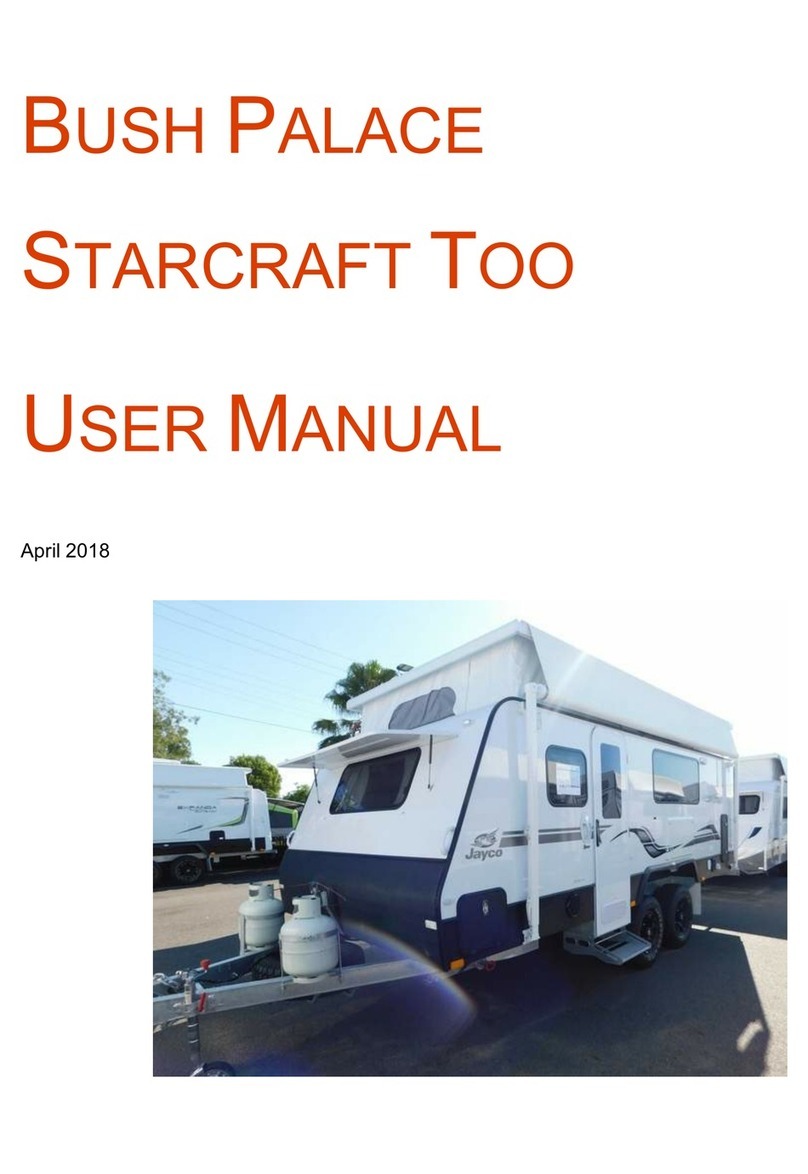
Bush Palace
Bush Palace STARCRAFT TOO user manual

Winnebago
Winnebago Minnie Winnie Premier owner's manual
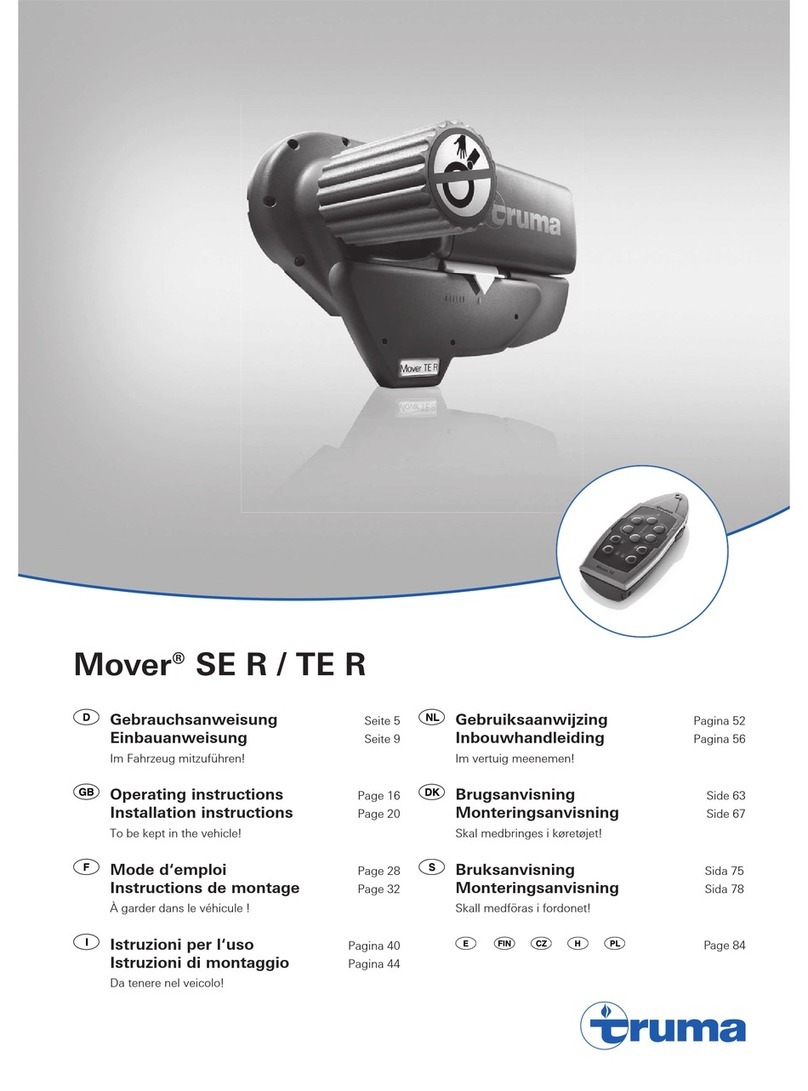
Truma
Truma Mover SE R Operating instructions & installation instructions

Hobby
Hobby optima manual

GMC
GMC Motorhome 1976 operating manual
